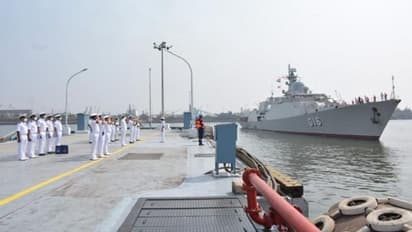Converging Interests: India and US Fortify Naval Coop to Checkmate China

Synopsis
Recently, the Indian Navy has stood out by leading anti-piracy missions in the Red Sea, the Indian Ocean and the Gulf of Aden, effectively tackling such threats as the renewed activity of Somali pirates.
The results from India's long election had shown Prime Minister Narendra Modi winning with a slightly smaller majority. But, even with some uncertainty around the poll results, one thing was clear: India views China as its main security threat. Voters from all political backgrounds agree that China is becoming a bigger challenge politically, economically and strategically.
This is especially clear in the maritime area, where India and China are competing for control. This struggle has major effects on both regional and global levels. Recently, the Indian Navy has stood out by leading anti-piracy missions in the Red Sea, the Indian Ocean and the Gulf of Aden, effectively tackling such threats as the renewed activity of Somali pirates.
PM Modi chairs NITI Aayog meeting in Delhi: BJP CMs attend, Mamata Banerjee present
India's increased naval activity is not just about its own goals, but also part of a bigger plan. A stronger Indian Navy helps the US by countering China’s actions in the Indo-Pacific region.
Strategic Importance of the IOR:
The Indian Ocean Region (IOR) is one of the most important and valuable areas in the world. It is a key trade route that connects several continents. About one-third of the world’s bulk cargo and two-thirds of international oil shipments pass through this region, highlighting its key role in global trade, energy and security. US officials often stress the need to keep the IOR peaceful and secure. This has become even more important as China’s presence in the area grows, creating major geopolitical worries for both the US and India.
Rise of India's Naval Ambitions:
From its first prime minister, Jawaharlal Nehru, to current leader Narendra Modi, India has consistently aimed at becoming a global power. However, the focus on becoming a naval power is a more recent development. This shift is partly due to historical territorial disputes with Pakistan and a cautious stance towards China since the 1962 Sino-Indian War.
Former head of India’s southern naval command, Vice-Admiral Anil Kumar Chawla reportedly told newsweek.com that one could not aim to be a global power without being a maritime power.
Modernizing the Indian Navy:
In 2018, at the Shangri-La Dialogue—an annual security summit in Asia where defence ministers, military chiefs and policymakers from various countries meet to discuss regional security issues and cooperation—Modi presented India’s modern vision for the Indo-Pacific region, emphasising the importance of working together, improving connectivity and ensuring maritime safety. New Delhi quickly started implementing these plans.
In recent years, the Indian Navy’s share of the country’s defence budget has increased from about 14% to 19%. In June 2023, the Indian Navy conducted a major exercise using two aircraft carriers, a feat that China has not yet achieved.
China's Strategy in Indian Ocean:
Despite these improvements, there is still a big gap in naval strength. China’s navy is over three times larger than India’s. Additionally, Beijing is effectively using this naval power by deploying stealth submarines to Pakistan, building artificial islands in the South China Sea and engaging in other activities to demonstrate its maritime strength. These actions are part of Beijing’s String of Pearls strategy, which focuses on creating naval bases and ports around the Indian subcontinent. This strategy has increasingly worried New Delhi.
India's Efforts to Counter China:
India is not the only country concerned. China’s growing influence in the Indian Ocean region also worries the US. To promote stability in the Indo-Pacific, the US is building regional partnerships, such as the Quad alliance with Japan, India and Australia. Supporting the growth of India’s naval capabilities is a logical next step. It aligns with America’s goal of countering China’s growing assertiveness and strengthens the already strong relationship between Washington and New Delhi.
By boosting technology and military sales, conducting joint exercises and improving information sharing, Washington can help India better monitor the Indo-Pacific waters. As both nations look to the future, dealing with China’s increasing presence in the Indian Ocean will remain a constant challenge. Therefore, boosting the strength of the Indian Navy should become a key strategic priority.
(The author of this article is a Defence, Aerospace & Political Analyst based in Bengaluru. He is also Director of ADD Engineering Components, India, Pvt. Ltd, a subsidiary of ADD Engineering GmbH, Germany. You can reach him at: girishlinganna@gmail.com)
Stay updated with the Breaking News Today and Latest News from across India and around the world. Get real-time updates, in-depth analysis, and comprehensive coverage of India News, World News, Indian Defence News, Kerala News, and Karnataka News. From politics to current affairs, follow every major story as it unfolds. Get real-time updates from IMD on major cities weather forecasts, including Rain alerts, Cyclone warnings, and temperature trends. Download the Asianet News Official App from the Android Play Store and iPhone App Store for accurate and timely news updates anytime, anywhere.